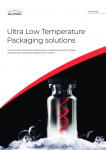On the industrialization of cell and gene therapy manufacturing: No scale without a seamless supply chain

Lonza recently entered a non-exclusive business collaboration with supply chain solutions provider, Vineti. The partnership aims to advance Lonza’s ‘vein-to-vein’ delivery network and mitigate risks and complexities associated with the developing supply chain.
To further discuss technology’s role in the supply chain, Outsourcing-Pharma (OSP) spoke with Lonza’s senior vice president and head of cell and gene technologies, Alberto Santagostino (AS), and co-founder and CEO of Vineti, Amy DuRoss (AD).
OSP: What would a perfect supply chain for cell and gene therapies look like? Do all supply chains for this type of therapeutics require ‘cold chain’?
AD: The only “perfect” supply chain for cell and gene therapy is one that works to get the right treatments to the right patients, safely and on time, and has the configurability to adjust to the natural and inherent variations in the different products and handling conditions.
So far, most of the discussion of supply chain has focused product by product. We need to build on that per-patient view, by incorporating industrialized supply chain capabilities that keep thousands of different patient-based drug products moving all at the same time. There will be countless variations in products, and yet we also need standardized systems that can manage them all if this industry is to scale.
In regards to cold chain, not all therapeutics require cold chain. Some therapeutics are fresh shipped product. It’s the ability to accommodate variations, manage scale, provide speed and safety -- and respond immediately if/when deviations happen – that define the “perfect” supply chain.
AS: Supply chain is a backbone function which handles an extremely high level of complexity and information, yet needs to feel smooth and invisible as it operates in the background. Without a seamless supply chain, you simply cannot operate at an industrial scale.
A perfect supply chain for cell and gene therapies should start by being designed and customized for cell and gene therapies and for each party in this process, particularly when it relates to patient-specific or autologous scheduling. It is not only critical to track in real-time the patient material from collection all the way back to infusion (what we refer to as the ‘vein-to-vein’ process), but also to provide the right information at the right time to the right party.
Maintaining the cold chain and monitoring temperatures and other key measurements in real-time is essential for patient material collected to produce the product as well as for the final product. It is all about having a supply chain that is built around the safety of patients, while treating high patient numbers seamlessly with an integrated ‘vein-to-vein’ network.
OSP: Are there any specific areas in the cell and gene therapy supply chain that require specific infrastructure?
AD: Yes, Chain of Identity (COI) and Chain of Custody (COC) are essential for clinical trust and patient safety. Providing COI and COC at scale requires best-in-class enterprise-grade software, a platform that is fully configurable and extensible. This “enterprise-grade” point is really important.
This industry cannot grow without a standardized, systematized, industrialized foundation. This is why Vineti was founded – there weren’t software solutions on the market to accommodate the complexity and variability of cell and gene therapy requirements when the first CAR-T therapies needed them to scale.
Patient safety and product quality also require the data infrastructure to capture real-time condition of the cells as they are transported via ground or air in specialized packaging. This data transparency, combined with automated COI/COC, provides a complete and transparent view of the drug product from cell collection through the supply chain to administration to the patient.
AS: Yes, and these will become more apparent as cell and gene therapies start treating more patients globally. I like to talk about ‘mass customization,’, which is the ability to treat patients with a completely customized product with the same efficiency as a mass-produced standard product.
So, you need a harmonized, orchestrated effort from initial contact with the patient, scheduling, collection of tissue, logistics, coordination of manufacturing time and place, and logistics back to the patient/hospital and scheduling of infusion.
OSP: What are some innovations improving the supply chain for cell and gene therapy?
AS: Most, if not all of the recent innovations in cell and gene therapy are made towards one goal: Tthe industrialization of cell and gene therapy manufacturing. When we talk about this industrialization, we first refer to automation of this manufacturing process made at each and every step of the way.
AD: Some of the key supply chain innovations include:
● Deployment of cloud technology: In cell and gene therapy, the product process and supply chain are distributed far beyond the pharma’s “four walls” and dedicated manufacturing teams. Cloud-based technology enables a process that requires many different types of users in many different locations.
● Consumer-grade usability and user experience: These personalized supply chains are incredibly complex and highly regulated. And since many of the system users and operators are not pharma manufacturing experts, the operation of these supply chains needs to be as simple as possible.
● Modular, configurable technology: Cell and gene therapy will only grow if they can scale from a standardized, readily-available foundation. If each new cell therapy requires its own unique set of individual operating technologies, health care providers, regulators, and contract manufacturers will drown in a sea of stand-alone systems and special use cases.
OSP: What role does technology play in today’s supply chain?
AD: Enabling technologies required for the successful production and delivery of cell and gene therapy and are working hard to keep up with scientific innovation. Cell and gene therapy supply chains have to cover far greater dependencies and requirements than other biologics, so each part of the supply chain has to leverage excellence in technology and in personnel to be successful. Without technology, these supply chains cannot be operated safely or efficiently at scale.
AS: To ensure the chain of custody and the cold chain are unbroken, today's technologies like automated track and trace and data-logging, are essential for patient safety. Cells are fragile materials and any prolonged time at incorrect temperatures can greatly diminish the efficacy of the product. This information must be traceable and auditable across the ‘vein-to-vein’ process to provide transparency to the treating physicians, manufacturing sites, and regulatory bodies.
OSP: How has globalization affected the supply chain?
AD: Globalization is testing supply chain readiness for cell and gene therapy in unprecedented ways. Therapies that are started in one region and shipped to another, for example, are growing in number -- – and have many more regulatory requirements to meet as a result.
Logistics are more stressed with multiple manufacturing locations, and different clinical sites across the globe have different processes and requirements to comply with. And we aren’t just serving commercial therapies on a global scale. Increasingly, clinical-stage therapies are also moving to multiple regions at once.
The use of cloud-based technology is absolutely essential here. So is the ability to use a configurable platform – for example, such a system can be set up to operate in one language in a particular region, and in a different language in another, and then can be updated to include a third language quickly as needed.
AS: Because cell and gene therapies are so personalized and sensitive to raw material and logistical disruptions, particularly autologous cell therapies, serving them globally means having a global network of sites to serve these therapies locally.
In terms of technologies, this means having a very efficient, integrated and tightly monitored/controlled supply chain both locally around each site and globally across all the sites.
OSP: How has technology integration improved the supply chain?
AS: Integration allows the drug developers to have a seamless connection between components such as logistics, data tracking, and manufacturing. This will not only provide cost and time savings but also and more importantly will reduce errors.
Having an integrated supply chain also supports maintaining the chain of identity, which is of utmost Importance in autologous processes such as CAR-T. Breaking the chain of identity can have serious, negative effects on patients and even be fatal.
AD: In cell and gene therapy, it all comes back to the individual. An individual – -- whether a donor or a patient -- – is at the core of the drug process and the drug product. So, the most important integrations tie most directly to the process for each individual product.
The Vineti-Lonza integration is a key example – we are working together to create a pre-built, standardized solution that will enable more patient products to be produced than ever before, by pre-connecting supply chain and manufacturing.
Other important integrations include connecting supply chain and courier systems, transport condition monitoring systems, clinical trial operation systems such as CTMS, business process systems such as ERP, and electronic batch record (EBR) systems.


















